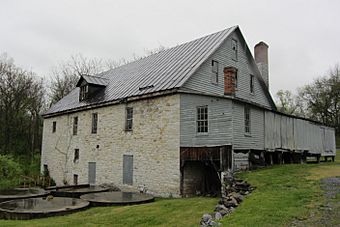Springdale Mill Complex facts for kids
|
Springdale Mill Complex
|
|

Springdale Mill, April 2012
|
|
| Location | US 11, near Bartonsville, Virginia |
|---|---|
| Area | 4.5 acres (1.8 ha) |
| Built | 1788 |
| Built by | Brown, David |
| NRHP reference No. | 82004559 |
Quick facts for kids Significant dates |
|
| Added to NRHP | July 8, 1982 |
The Springdale Mill Complex, also known as Springdale Flour Mill, is a very old group of buildings located near Bartonsville, Virginia in Frederick County, Virginia. It's a special place because it includes a historic grist mill, which is a type of mill that grinds grain into flour. This mill was built a long time ago, around 1788.
Contents
Discovering Springdale Mill
Springdale Mill is a fascinating historical site. It shows us how people used to make flour before modern factories existed. The main mill building is made from strong, rough limestone rocks that were carefully stacked in rows. It also has wooden sections at the ends of its roof.
What is a Grist Mill?
A grist mill is a building where grain, like wheat or corn, is ground into flour or meal. This process uses large grinding stones, often powered by water. The Springdale Mill would have used the power of a nearby stream or river to turn its machinery. This was a very important job in the past, as flour was a basic food item for everyone.
Buildings at the Complex
Besides the main mill building, the Springdale Mill Complex also has other structures. These include several smaller buildings that were built later, in the late 1800s and early 1900s. There are also two homes on the property. One house is made of the same kind of stacked limestone as the mill. The other house is made of wood. These buildings together show what a working mill complex looked like in the past.
A Historic Landmark
The Springdale Mill Complex is recognized as an important historical site. It was officially added to the National Register of Historic Places in 1982. This is a list of places in the United States that are considered worthy of preservation because of their historical significance. Being on this list helps protect the mill and its buildings for future generations to learn from and enjoy. It was also added to the Virginia Landmarks Register in 1981, which is a similar list for important places within the state of Virginia.



